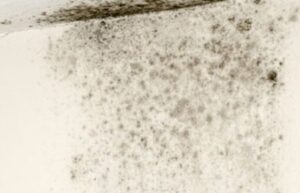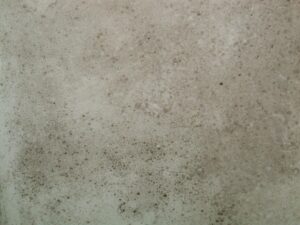What is Penetrating Damp?
Penetrating dampness is the infiltration of moisture through walls or other building structures due to water entering through cracks, joints, or other defects.
It is a common problem in buildings, particularly those that are older, and can cause damage to the fabric of the structure as well as create an unhealthy living or working environment.
How does Penetrating Damp Cause Mould Growth?
Penetrating dampness occurs when moisture passes through a structure, such as a wall, roof, or window, and can cause mould growth by providing a source of water and a damp surface for mould spores to attach to and grow.
Mould typically needs a temperature of at least 60°F and a relative humidity of 70% or higher in order to thrive. When a structure has penetrating dampness, the moist surfaces can provide an ideal environment for mould growth, allowing spores to colonise and spread.
Additionally, a damp environment may also encourage dust mites, which can create an additional allergenic problem in the home.

The Impact of Penetrating Damp on a Home
Penetrating dampness can have a significant impact on a home and its inhabitants. The dampness can cause damage to the walls, ceilings, and floors, and can also lead to the growth of mould and mildew, which can cause health problems such as asthma and allergies.
In addition, the dampness can also lead to damage to furniture, wallpaper, carpets, and clothing. The dampness can also cause a musty smell in the home and make it difficult to keep it warm, as the damp air does not allow the heat to circulate properly.
In extreme cases, the dampness can cause structural damage to the home, such as the weakening of floors, walls, and ceilings.
Signs and symptoms of penetrating damp
Common signs and symptoms of penetrating dampness can include:
- Water staining or discoloration on walls, ceilings, and floors.
- Warping, blistering, or peeling paint or wallpaper.
- Musty odours come from walls, floors, or ceilings.
- Mould and mildew growth in damp areas.
- Condensation water droplets on walls, floors, or ceilings.
- Damage to internal structures such as wood rot and rusting of metal fixtures.
- Peeling, blistering, or cracking of paint and plaster
- Crumbling or flaking mortar
- Discoloured patches on walls or ceilings
- Musty smell
- Stains on walls or ceilings
- Mould growth
- Warping of wood, including skirting boards, window frames, and floorboards
- Damage to wallpaper
- Efflorescence (white powdery salt deposits)
- Condensation on walls or windows
- Peeling or bubbling paint or wallpaper
- Fungal growth or musty odours
- Discoloration or staining of the walls
- Warping or swelling of doors and windows
- Cracking in masonry or plasterwork
- Condensation on cold surfaces
- Cold walls or floors
- Damp patches on walls or floors
How to prevent and treat penetrating damp?
- Install a damp-proof course: A damp-proof course (DPC) is a physical barrier laid in between the joists of a building to help prevent rising dampness. It is made from a material that does not absorb moisture, such as bitumen, and is laid in a continuous line around the walls of a building.
- Check for and repair any broken or blocked guttering or downpipes: If rainwater is unable to drain away from a building, it can cause penetrating dampness. Check your guttering and downpipes regularly to ensure they are clear of debris, and that they are not blocked or broken.
- Ensure that any external walls are properly insulated: External walls should be properly insulated to help reduce the risk of penetrating dampness. This can be done by installing cavity wall insulation, or by adding external cladding such as brick slips.
- Check the roof and repair any damage: If there are gaps, cracks, or holes in the roof, they need to be repaired as soon as possible. These gaps can allow rainwater to enter the building and cause penetrating dampness.
- Treat any affected areas with a waterproofing solution: If an area has already been affected by penetrating dampness, it can be treated with a waterproofing solution. This can help to stop the problem from getting worse and prevent the dampness from spreading.
- Have a professional assessment: Identify the source of the penetrating dampness. This could be from a leaky roof, blocked gutters, rising dampness, or lack of ventilation.
Other methods to prevent dampness:
- Install a ventilation system to allow air to circulate and remove moisture from the air.
- Repair or replace any damp or damaged plaster, bricks, and mortar.
- Consider painting or coating walls with breathable waterproof paint.
- If necessary, install a dehumidifier to reduce humidity levels.
- Check for signs of condensation and treat it with mould-resistant paint.
- Use a damp metre to measure the level of moisture in your walls and take appropriate action.
- Ensure that any new building work is adequately insulated and ventilated.
What is mould growth?
Mould growth is the formation and spread of microscopic, filamentous fungi in moist, warm environments. Mould produces spores, which are tiny particles that spread through the air and can cause allergic reactions and other health problems.
Mould growth can occur on a variety of surfaces, including fabric, paper, wood, and food. It can also grow on walls, floors, and other surfaces in homes, offices, and other buildings.

What are the signs of mould growth?
The signs of mould growth include musty odours, visible discoloration or staining on walls or ceilings, black or green spots on walls or other surfaces, and/or visible mould growth.
Additionally, individuals may experience allergy-like symptoms such as sneezing, coughing, or watery eyes when exposed to mould.
How can you prevent mould growth from penetrating damp?
- Reduce humidity levels in your home by using dehumidifiers and increasing ventilation.
- Use a water-resistant barrier to seal any potential sources of moisture in your homes, such as around windows, doors, and pipes.
- Address any leaks promptly and repair any roof and plumbing issues.
- Regularly clean and inspect areas prone to mould growth and use mould-resistant paint.
- Ensure that your home is well insulated and that any insulation is dry.
- Clean and maintain gutters and downspouts to ensure that water is directed away from your home.
- Use exhaust fans in bathrooms and kitchens to help reduce humidity.





